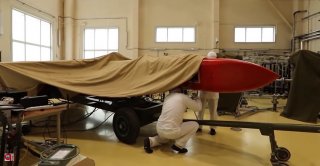Russia is Showing Off Its Nuclear Missiles (Again)
“Russia’s preparations to resume testing the Burevestnik missile, NATO codename Skyfall, come as the U.S. seeks to renegotiate the New START treaty with Russia, which this capability circumnavigates."
Here's What You Need To Remember: According to defense analyst Anthony Endresen, the purpose of the missile demonstration is twofold. First, it displays the strength of Russia's armed forces to the world; second, it distracts from the country's bungled response to the Covid-19 pandemic.
In August 2019 citizens living near the State Central Navy Testing Range at Nyonoksa near Severodvinsk in northern Russia had to deal with the “Skyfall Incident”—and while it might have sounded like something out of a James Bond movie, it was far more serious and potentially deadly. It involved a Russian-built 9M730 Burevestnik nuclear rocket—known as the SSC-X-9 Skyfall to NATO—which exploded at the military base and caused a 30-minute spike in radiation levels.
Last week, CNN reported that new satellite images suggest that Russia could be preparing to resume test flights at the previously-dismantled launch site near the Arctic Circle and that they likely involve the controversial missile.
The New Strategic Arms Reduction Treaty (New START) could be a key to why this testing is coming now.
“Russia’s preparations to resume testing the Burevestnik missile, NATO codename Skyfall, come as the U.S. seeks to renegotiate the New START treaty with Russia, which this capability circumnavigates, as well as looming U.S. elections,” explained Anthony Endresen, aerospace and defense analyst at data analytics company GlobalData, via an email to The National Interest.
“With the Zircon Hypersonic missile having undergone successful tests a fortnight ago, Russia’s domestic position is a key factor in the timing of this process,” added Endresen. “As the successful testing of strategic weapons such as Zircon and Skyfall play to the strengths of Putin’s government, the administration is seen as successfully strengthening Russia and rehabilitating the armed forces in particularly volatile times. Proceeding with these tests is intended to demonstrate Russia’s preparedness to face future defenses with advanced technologies, while drawing attention away from the country’s current Covid-19 problems.”
Future Tests
The satellite images from last month show new structures, which further prompted experts to believe that additional tests of the Skyfall are pending. These could come as early as next month, which would be three years after the first tests were conducted on the platform in 2017.
Little is known about the exact design of the cruise missile, but experts suggest it employs a nuclear-powered ramjet engine, and uses a rocket booster to accelerate to an optimal speed. It could certainly present a real threat to U.S. military targets including capital warships such as an aircraft carrier.
“From a military standpoint, this missile represents a means for Russia to overcome future missile defenses in order to maintain a credible deterrent, in addition to allowing the Russian armed forces to target U.S. carrier groups at range,” said Endresen. “The use of nuclear propulsion in the weapon is strategic as it means that Russia is perceived to be lowering the threshold for going nuclear in conflict, given it is inherently a nuclear weapon regardless of the warhead. The Russian counterargument to that point would be that targeting a carrier group would receive a nuclear response, whatever weapons are used in the strike.”
Changing Market
It is also likely that missile platforms such as the Skyfall will be of increasing interest to the major military powers of the world because of the capabilities these systems offer. It could result in a new nuclear arms race and one that could get expensive very quickly. According to GlobalData, the strategic land-attack missile defense market will have a compound annual growth (CAGR) of 4.72 percent from 2020 to2030, growing from $3,560.1 million to $5,647.4 million during that period.
“The Skyfall is explicitly intended to counter future defense systems, much like Zircon for non-nuclear use, and the Poseidon (NATO name Kanyon) for nuclear naval use,” added Endresen.
“The nuclear propulsion aspect of the weapon is key to performance, in addition to demonstrating Russian advances in propulsion and advanced technologies. Russia’s 2020 expenditure of $11,425 million on missiles and missile defense procurement point to it being a vital area of the defense establishment, with expected 2030 expenditures of $13,304 million showing this trend to continue,” he noted. “Given that these are procurement figures and do not include research or development costs, such as those for this weapon, it is evident Russia is very heavily invested in advancing its missile technology and fielding advanced systems.”
Peter Suciu is a Michigan-based writer who has contributed to more than four dozen magazines, newspapers and websites. He is the author of several books on military headgear including A Gallery of Military Headdress, which is available on Amazon.com.
Image: Pravda, courtesy of YouTube.

